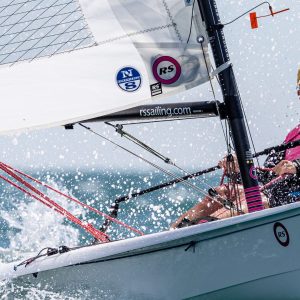Do you know why the RS Aero Hull is 4m long?
Yes the hull looks stunning, if you don’t mind us saying so ourselves, but there’s so much more going on there than just fantastic aesthetics. The testing and development that went into the RS Aero was extensive and can be attributed to the success of this modern day single-hander and why she’s such a delight to sail across the size ranges. Keep reading below to find out all of the key features of the RS Aero hull.
Hull size
- Testing showed that 4m length is long enough to support the larger helmsman, without being a handful for small sailors to launch and recover
- 1.4m beam conveniently fits a normal roof-rack
 Chine
Chine
- A chined hull gives sailors more reserve stability.
- The chine peels off spray when sailing downwind and gives greater dynamic stability.
- The flatter hull panels of a chined hull allow construction from flat sheets of PU foam, reducing the weight of the core bond (cores designed to mould around tighter curves “absorb” more resin into their score cuts or honeycomb).
- The chine sits just below the water line amidships – for several advantages:
- A 35kg sailor gains approximately the same waterline beam and hence the same hull form stability as a heavier sailor.
- The RS Aero is so light there is less inertial mass to pull against when moving in during a lull or header – compensated for by the flatter hull and increased form stability.
- The chine has a small lip to reduce spray, drag and for precise positioning of the computer-cut foam panels during construction.
Gunwale design
- As the RS Aero is relatively narrow we have optimised the width with the modern approach of running the gunwale parallel to the centreline in the aft half of the boat. Advantages are:
- Maximum righting moment wherever the helm sits out, irrespective of fore and aft position
- When capsized the topside buoyancy is kept to a minimum – the boat floats lower allowing easier reach to the daggerboard
- The abrupt change of deck line at the front of the cockpit allows a fine bow without pushing out the overall width or the topsides forward
- The hull and deck are joined with a conventional gunwale. We have used the U section gunwale for the RS Aero because it creates an important carbon laminate “box frame” around the boat and distributes rig loads through a light, efficient structure. It makes righting the boat from inverted faster and safer – the gunwale gives a significantly drier and more pleasant ride upwind & tight reaching – it makes the boat much easier to hold when launching and recovering, especially in waves.
 Flat panel deck
Flat panel deck
- We have used, where possible, a flat panel deck to keep straight load-paths with structural corners – so minimizing weight.
- Numerous deck profiles were tested to maximise hiking comfort whilst maintaining good “kick off” surfaces when roll tacking – and a secure feeling when sailing downwind in breeze. Styling led temptation to cut-away the deck at the transom was resisted – it is useful to sit on when bearing away in extreme conditions.
Do you want to find out more? Head to our RS Aero page for more information or call the office on 01324 861 756.


 Chine
Chine Flat panel deck
Flat panel deck